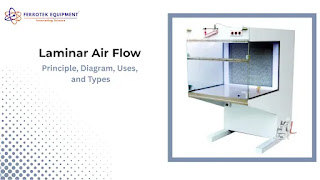What is Laminar Air Flow – Principle, Diagram, Uses, and Types
In industries where maintaining a clean, sterile, and particle-free environment is crucial, Laminar Air Flow (LAF) systems play an essential role. These systems are specially designed to protect sensitive processes and materials from airborne contaminants by providing a continuous, unidirectional flow of filtered air. In this article from Ferrotek Equipment, we’ll explain what Laminar Air Flow is, how it works, its uses, different types, and include a basic diagram for clarity.
What is Laminar Air Flow?
Laminar Air Flow (LAF) refers to a controlled airflow environment where air moves in a single, uniform direction — typically either horizontal or vertical — with constant speed and minimal turbulence. This steady, unidirectional flow ensures that any airborne particles are consistently swept away from the critical working area, thus maintaining a contamination-free zone.
LAF systems are commonly used in industries like pharmaceuticals, biotechnology, electronics, food processing, and research laboratories where maintaining a sterile environment is necessary for safety, accuracy, and quality control.
Principle of Laminar Air Flow
The basic working principle of Laminar Air Flow is to pass air through High-Efficiency Particulate Air (HEPA) filters or Ultra-Low Penetration Air (ULPA) filters to remove airborne particles, bacteria, and other contaminants. Once filtered, the clean air is directed in a laminar (unidirectional) flow over the working area to protect the product or operation from contamination.
Key principles include:
-
Air Filtration: Air is drawn from the environment and passed through pre-filters to remove large particles.
-
HEPA/ULPA Filtering: The pre-filtered air is then forced through a HEPA or ULPA filter, removing 99.97% (HEPA) or 99.999% (ULPA) of particles ≥ 0.3 microns.
-
Unidirectional Airflow: The clean air moves in a straight, constant stream across the workspace, pushing contaminants away.
-
Positive Pressure Environment: The clean area maintains slightly higher pressure than surrounding areas to prevent the infiltration of unfiltered air.
Diagram of Laminar Air Flow
Here’s a simple diagram to illustrate how a Laminar Air Flow system operates:
In horizontal LAF, the filtered air flows horizontally across the workspace, while in vertical LAF, the air moves from top to bottom.
Uses of Laminar Air Flow
Laminar Air Flow systems are widely used in various fields where product and process protection from airborne contamination is critical. Some common applications include:
-
Pharmaceutical Production: For sterile filling, compounding, and packaging processes.
-
Biotechnology Labs: To protect cell cultures and other sensitive materials from contamination.
-
Hospital Operating Rooms: To reduce surgical site infections
by maintaining a sterile environment. -
Electronic Manufacturing: To assemble semiconductors and microelectronic devices free from dust particles.
-
Food Industry: In packaging and preparation of contamination-sensitive products.
-
Research and Quality Control Labs: For testing samples without contamination risk.
Types of Laminar Air Flow
Laminar Air Flow systems can be broadly classified based on the direction of airflow:
-
Horizontal Laminar Air Flow:
In this type, clean air moves from the back of the unit towards the front in a horizontal direction, sweeping away particles from the workspace. -
Vertical Laminar Air Flow:
Here, filtered air moves from the top of the unit downwards towards the working area, effectively pushing contaminants downward and away from the product.
Both types have specific advantages depending on the nature of the work, the available space, and safety considerations.
Conclusion
Laminar Air Flow systems are vital tools in maintaining clean, sterile, and particle-free environments in a variety of industries. By ensuring a continuous flow of HEPA or ULPA filtered air, these systems protect products, processes, and personnel from harmful airborne contaminants. At Ferrotek Equipment, we specialize in providing high-quality, reliable Laminar Air Flow systems designed to meet the unique needs of your facility.



Comments
Post a Comment